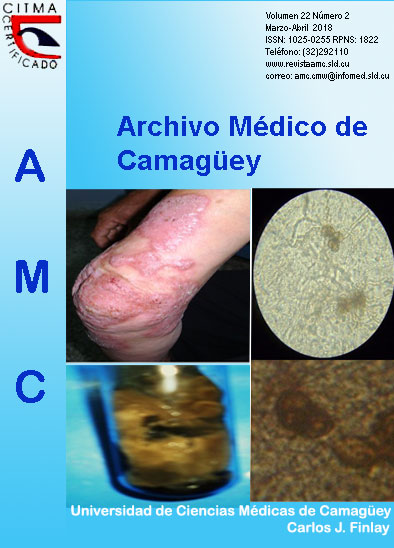Analysis of some nursing theories and their applicability in Cuba
Keywords:
Enfermería, teoría, bases conceptualesAbstract
Background: modern nursing began in the mid-nineteenth century. One of the first official training programs for nurses was inaugurated in 1836 in Kaiserswerth, Germany, by Pastor Theodor Fliedner for the Protestant Dianonisas order. At that time in Europe, other religious orders were also offering nursing training in a regulated manner, but the school of Fliedner is worth mentioning for having being formed in it the reformer of the British nursing Florece Nightingale.
Objective: to analyze the theories of nursing and their validity of application in Cuba.
Methods: a bibliographic review was carried out using the method of bibliographic analysis through a search carried out between 1994 and 2017, where specialized databases were consulted and 28 scientific publications on the subject were selected.
Development: the essence of nursing is care and its objects of study are: the trinomial individual-family-community. In practice, the scope of the professional work they perform in daily practice is not always appreciated. In most cases, nurses apply the theoretical references from their discipline, which reinforce individual care. Some elements of the theory have significantly influenced the training of nurses, such as the importance of health education, the observation of health problems, the maintenance of ethical behavior towards the patient, the need for the provision of services domiciliary, the realization of organizational activities, administration and scientific research for the development of science.
Conclusions: the complexity of people’s care, groups and communities facing nursing imposes the need to integrate the approach of theories and their practice in order to consolidate their status of science and their contribution to public health in Cuba. However, there are still gaps in its application.
DeCS:NURSING; NURSING THEORY; KNOWLEDGE BASES; NURSING PROCESS; REVIEW LITERATURE AS TOPIC.
Downloads
References
1.Young P, Hortis De Smith V, Chambi MC, Finn BC. Florence Nightingale (1820-1910), a 101 años de su fallecimiento. Rev méd Chile [Internet]. Jun 2011 [citado 11 Nov 2016];139(6):[aprox. 7 p.]. Disponible en: http://www.scielo.cl/scielo.php?script=sci_arttext&pid=S0034-98872011000600017&lng=es
2. Velázquez Aznar A, Dandicourt Thomas C. Florence Nightingale. La dama de la lámpara (1820-1910). Rev Cubana Enfermer [Internet]. Dic 2010 [citado 11 Nov 2016];26(4):[aprox. 3 p.]. Disponible en: http://scielo.sld.cu/scielo.php?script=sci_arttext&pid=S0864-03192010000400001&lng=es
3.Rayle M, Marrimer A. Modelos y teorías en enfermería. 7ma ed. España: Harcourt; 2011.
4.BerjagaPernía L. Vigencia del pensamiento nightingaleano en la enfermería profesional cubana de 1909-1925. Rev Cubana Enfermer [Internet]. Ago 2004 [citado 12 Oct 2017];20(2):[aprox. 1 p.]. Disponible en: http://scielo.sld.cu/scielo.php?script=sci_arttext&pid=S0864-03192004000200010&lng=es
5 Amaro Cano M del C. Florence Nightingale, la primera gran teórica de enfermería. Rev Cubana Enfermer [Internet]. Dic 2004 [citado 11 Nov 2016];20(3). Disponible en: http://scielo.sld.cu/scielo.php?script=sci_arttext&pid=S0864-03192004000300009&lng=es
6.Feliu Escalona B, Estrada Muñoz R. Modelo atención de enfermería comunitaria [Internet]. La Habana: WALSUD; 1997 [citado 10 Ene 2015]. Disponible en: https://es.scribd.com/document/183771586/modelo-atencion-enfermeria-pdf
7.Barroso Romero Z, Torres Esperón JM. Fuentes teóricas de la enfermería profesional: Su influencia en la atención al hombre como ser biosicosocial. Rev Cubana Salud Pública [Internet]. Jun 2001 [citado 11 Nov 2016];27(1):[aprox. 7 p.]. Disponible en: http://scielo.sld.cu/scielo.php?script=sci_arttext&pid=S0864-34662001000100002&lng=es
8.Prado Solar LA, González Reguera M, Paz Gómez N, Romero Borges K. La teoría Déficit de autocuidado: Dorothea Orem punto de partida para calidad en la atención. Rev Med Electron [Internet]. Dic 2014 [citado 12 Oct 2017];36(6):[aprox. 10 p.]. Disponible en: http://scielo.sld.cu/scielo.php?script=sci_arttext&pid=S1684-18242014000600004&lng=es
9.Naranjo Hernández Y, Concepción Pacheco JA. Importancia del autocuidado en el adulto mayor con diabetes mellitus. Rev Finlay [Internet]. 2016 [citado 11 Oct 2016];6(3):[aprox. 5 p.]. Disponible en: http://revfinlay.sld.cu/index.php/finlay/article/view/400
10.Massó Betancourt E, Fernández Guindo JA, Macías Bestard C, Betancourt Borges Y. Valoración de algunas teorías de enfermería y la vigencia en la práctica cubana. Rev Cubana Enfermer [Internet]. Dic 2008 [citado 12 Oct 2017];24(3-4):[aprox. 8 p.]. Disponible en: http://scielo.sld.cu/scielo.php?script=sci_arttext&pid=S0864-03192008000300007&lng=es
11.Díaz de Flores L, Durán de Villalobos MM, Gallego de Pardo P, Gómez Daza B, Gómez de OE, González de Acuña Y et al. Análisis de los conceptos del modelo de adaptación de Callista Roy. Aquichán [Internet]. Dic 2002 [citado 12 Oct 2017];2(1):[aprox. 14 p.]. Disponible en: http://www.scielo.org.co/scielo.php?script=sci_arttext&pid=S1657-59972002000100004&lng=en
12.Fawcett J. The nurse theorist: 21st-century updates-Callista Roy. Nursing Science Quarterly [Internet]. 2002 [citado 15 Ene 2008]. Disponible en: http://nsq.sagepub.com/cgi/reprint/15/4/308
13.Whittemore R, Roy C. Adaptingto Diabetes Mellitus: a Theory Synthesis. Nursing Science Quarterly [Internet]. 2002 [citado 15 Ene 2008]. Disponible en: http://nsq.sagepub.com/content/abstract/1574/311
14.Cavalcante O, Leite A. Crisis hipertensiva: estudio de caso con utilización de la clasificación de las intervenciones de enfermería para alcanzar respuestas adaptativas basadas en el Modelo Teórico de Roy. Acta paul enferm [Internet]. 2005 [citado 15 Ene 2008]. Disponible en: http://www.scielo.br/scielo.php?script=sci_arttext&pid=S010321002005000300003&lng=es&nrm=iso
15.Guillén Fonseca M. Reflexión de la conceptualización en la investigación de enfermería en Cuba, 1999. Rev Cubana Enfermer [Internet]. Abr 2000 [citado 12 Oct 2017];16(1):[aprox. 7 p.]. Disponible en: http://scielo.sld.cu/scielo.php?script=sci_arttext&pid=S0864-03192000000100002&lng=es
16.Leddy S, Pepper JM. Bases Conceptuales de la Enfermería Profesional. Filadelfia: J. B. Lippincott Company; 2000.
17.Morfi Samper R. Gestión del cuidado en Enfermería. Rev Cubana Enferm [Internet]. 2010 [citado 9 Jul 2014];26(1):[aprox. 2 p.]. Disponible en: http://scielo.sld.cu/scielo.php?script=sci_arttext&pid=S0864-03192010000100001&lng=es&tlng=es
Published
How to Cite
Issue
Section
License
Copyright: Camagüey Medical Archive Magazine, offers immediately after being indexed in the SciELO Project; Open access to the full text of the articles under the principle of making available and free the research to promote the exchange of global knowledge and contribute to a greater extension, publication, evaluation and extensive use of the articles that can be used without purpose As long as reference is made to the primary source.
Conflicts of interest: authors must declare in a mandatory manner the presence or not of conflicts of interest in relation to the investigation presented.
(Download Statement of potential conflicts of interest)
The Revista Archivo Médico de Camagüey is under a License Creative Commons Attribution-Noncommercial-No Derivative Works 4.0 International (CC BY 4.0).
This license allows others to distribute, to mix, to adjust and to build from its work, even for commercial purposes, as long as it is recognized the authorship of the original creation. This is the most helpful license offered. Recommended for maximum dissemination and use of licensed materials. The full license can be found at: https://creativecommons.org/licenses/













 22 julio 2025
22 julio 2025